Are you questioning the best way to configure a Area Title System (DNS) in your WordPress web site however don’t know the best way to get began?
DNS is sort of a phonebook for the web, because it helps to find your web site. Nonetheless, establishing WordPress DNS may be overwhelming for a lot of web site homeowners.
On this final information, we’ll present WordPress DNS configuration for learners.
Here’s a fast overview of what we’ll cowl within the information. You may click on the hyperlinks under to leap forward to any part:
What’s WordPress DNS?
DNS or Area Title System allows you to connect with web sites by translating human-readable domains into IP addresses.
While you enter an internet site URL (like wpbeginner.com) in your browser, DNS interprets it into a singular ID of the server the place the positioning is saved (like an IP tackle 192.124.249.166) and helps level your gadget in the precise course.
A site title and its matching IP tackle are referred to as DNS data.
When operating a WordPress web site, it’s vital to know how these data work and correctly configure DNS.
Let’s take a look at how DNS works and what goes on within the background once you go to an internet site.
How Does DNS Work?
You may consider DNS as a cellphone listing for the web the place you’ll discover instructions to all of the web sites.
You may simply perceive how DNS works by following these steps:
Let’s say you kind www.wpbeginner.com in your browser and hit the Enter button. Instantly, a fast search will happen to see if you happen to’ve visited the positioning beforehand. If there’s a DNS file present in your laptop’s DNS cache, you then’ll be taken to the positioning instantly.
If there isn’t a DNS file, then a question is shipped to the DNS server. That is normally your web service supplier’s server or the area host’s resolving nameserver.
If the file will not be cached on the resolving nameserver, then they’re forwarded to the ‘root nameservers.’ These are servers world wide accountable for storing DNS information.
As soon as the DNS file is discovered within the root nameservers, it’s cached by your laptop. They’re then positioned, and a connection is established between the server the place your web site is saved. Now you can view www.wpbeginner.com in your display screen.
To make it a bit of clearer, you may see the method outlined within the picture under:
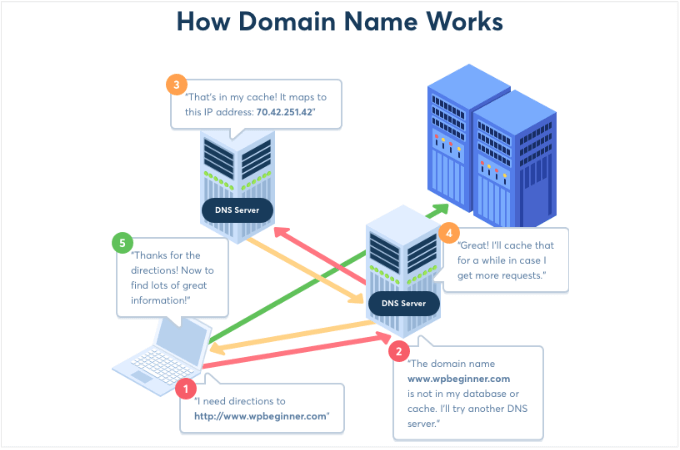
To be taught extra, you may see our information on what’s a site title and the way domains work.
Configuring WordPress DNS Settings
Now that you understand what DNS is and the way it works, let’s take a look at how one can configure it in your WordPress web site.
Often, DNS settings are managed by your area registrars and WordPress internet hosting firm. You may entry them to handle the DNS data and edit various kinds of data.
Do observe that the settings could fluctuate relying on the internet hosting service you’re utilizing. For the sake of this text, we’ll use Bluehost.
First, you’ll have to log in to your Bluehost account and head to Domains from the menu on the left.
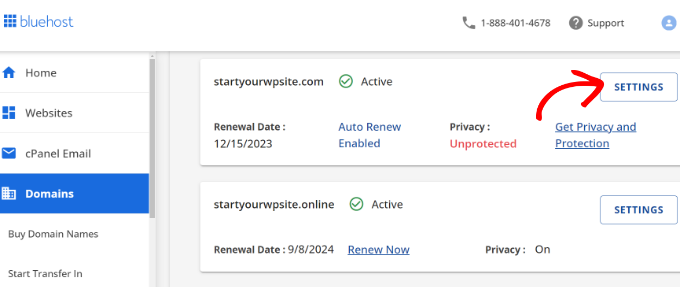
Subsequent, you may find your web site and click on the ‘Settings’ button.
After that, you’ll see totally different area settings in Bluehost. Merely scroll down and click on on the ‘Superior Instruments’ choice.
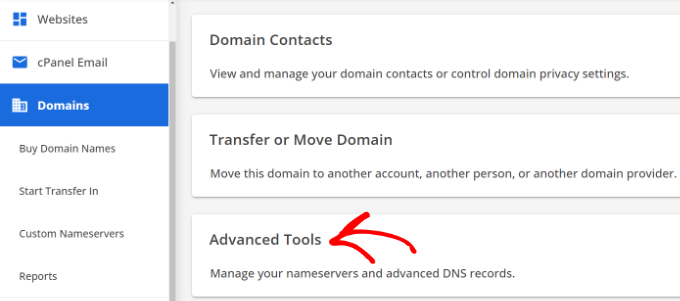
From right here, you’ll see the Superior Instruments part develop and present totally different choices.
Right here, Bluehost will present the nameservers in your area and different data. To handle DNS data, you may click on the ‘Handle’ button in entrance of Superior DNS Data.
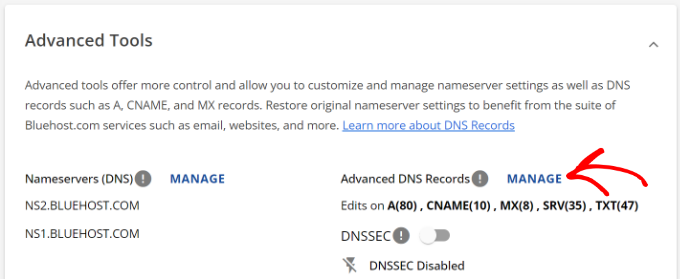
Subsequent, Bluehost will show a warning message that solely superior customers ought to change the DNS data.
You may merely click on the ‘Proceed’ button.

On the following display screen, you see a number of forms of DNS data.
Now you can change these data and configure DNS in your WordPress web site.
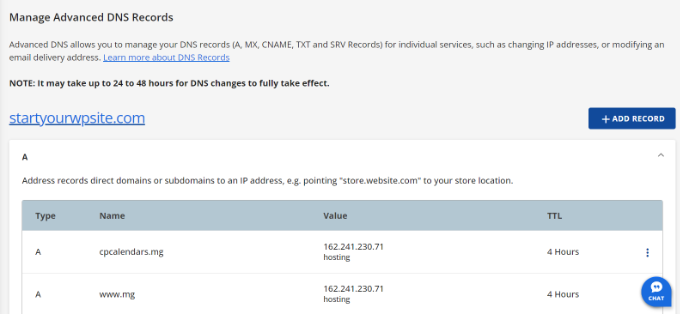
A few of these data embrace:
Deal with Report or A Report – It directs domains and subdomains to an IP tackle.
CNAME – Brief for Canonical Title Report, this file factors one area or subdomain to a different area title.
MX (Mail Exchanger) Report – The primary exchanger directs emails to a selected server that handles emails in your area.
TXT Data – It presents descriptive area info in textual content format to different providers, like Google Search Console.
How you can Change Area Nameservers
Area Nameservers are particular forms of servers that hold all of the DNS data of your area title. Its function is to offer the DNS info to anybody requesting it.
You may entry the nameserver in your web site by way of the WordPress internet hosting service or area title registrar. Every nameserver can have its personal tackle and might retailer data of a number of web sites.
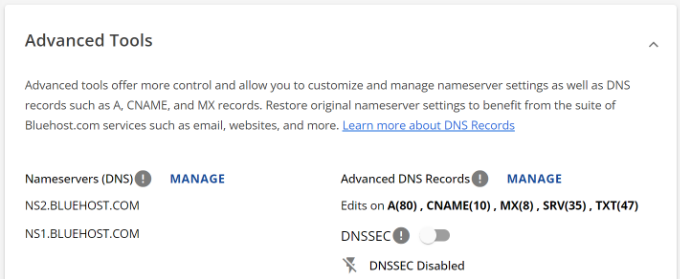
Do observe that the nameserver tackle could fluctuate relying in your internet hosting supplier or area registration service.
For instance, if you happen to’re utilizing Bluehost, then the nameservers will seem like this:
NS1.bluehost.com
Often, there are 2 most important causes for altering the nameservers.
First, you’re switching to a brand new website hosting service. Second, it’s essential to add an internet software firewall (WAF) like Sucuri or Cloudflare.
For those who’re shifting your WordPress web site to a brand new internet hosting supplier, then it’s important to vary the nameserver info. This fashion, your area is pointed in the direction of the brand new internet hosting location.
Moreover that, implementing a firewall to your web site utilizing a WordPress WAF plugin may also require altering the nameservers. That’s as a result of WAF plugins will shield your web site from cyberattacks by blocking them on the DNS stage.
The steps for enhancing the area nameservers will rely on the internet hosting supplier or area registrar. You may observe our information on the best way to simply change area nameservers to be taught extra.
Correctly Setting Up Redirections in WordPress
Redirections are a vital a part of WordPress DNS configuration. Whereas redirection doesn’t occur on the DNS stage, many area registrars will help you arrange redirections when configuring your web site’s DNS settings.
For instance, once you’re migrating an internet site to a brand new area or redirecting a URL to a different hyperlink, then your DNS data must be up to date as effectively.
For those who’re doing redirections manually, then there are numerous possibilities of errors. This will result in a problem the place your WordPress web site redirects to the previous area after migration.
One of many main causes of this difficulty is DNS points. If a DNS file isn’t up to date or the DNS server isn’t responding, then customers gained’t be capable to view the brand new web site URL.
You may keep away from this by utilizing a WordPress search engine optimization plugin like AIOSEO. It presents a robust redirection supervisor that allows you to arrange redirections in WordPress and carry out full web site redirects.

Utilizing AIOSEO, you may simply migrate your area and arrange redirects with out worrying about DNS points. Plus, the plugin reveals a 404 error log and helps repair damaged hyperlinks.
For extra particulars, please see our information on the best way to correctly do a full web site redirect in WordPress.
How you can Change MX Data for WordPress Website
MX or Mail Change data inform the web servers the place to ship e mail coming to and out of your web site area title.
You’ll want to vary the MX data to create a enterprise e mail tackle together with your area title.
For instance, let’s say you wish to create an expert e mail tackle utilizing Google Workspace together with your area title ([email protected]). You’ll want to vary the MX data and route all of your emails by way of Gmail servers.
One other scenario the place you’d have to replace or add MX data is whereas utilizing an SMTP supplier to ship WordPress emails. An SMTP service improves e mail deliverability and ensures your emails don’t find yourself in spam.
To vary or add MX data, you’ll have to log in to your WordPress internet hosting supplier or area registrar.
For example, if you happen to’re utilizing Hostinger, then you may go to the Domains part and entry the ‘DNS / Nameservers’ part. Subsequent, you may add a brand new file within the Handle DNS data space and select MX because the file kind.
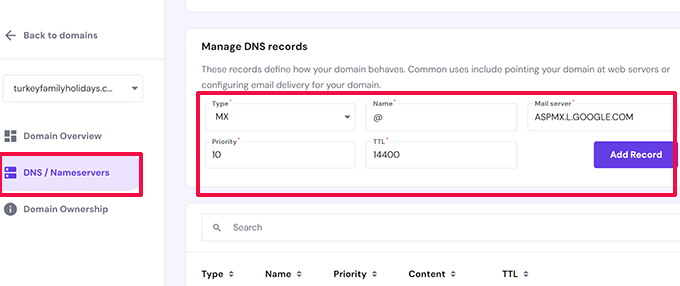
You’ll find full step-by-step tutorials for a number of internet hosting providers and area registers in our information on the best way to change MX data for WordPress websites.
How you can Clear DNS Cache from Your Laptop
Have you ever ever been requested to flush the DNS cache in your laptop?
A DNS cache is like an tackle guide that accommodates all of the IP addresses of every web site you’ve got visited. Nonetheless, the DNS cache info can get outdated and result in a number of DNS-related points in your WordPress web site.
Flushing or clearing the DNS cache can resolve plenty of these points. It permits your laptop to collect contemporary DNS info and replace the cache.
Now, the steps for flushing DNS cache fluctuate for Home windows, Mac, and Chrome. For example, in Home windows, you’ll have to open the Command Immediate device and kind the next command. Mac customers can do that within the Terminal app.
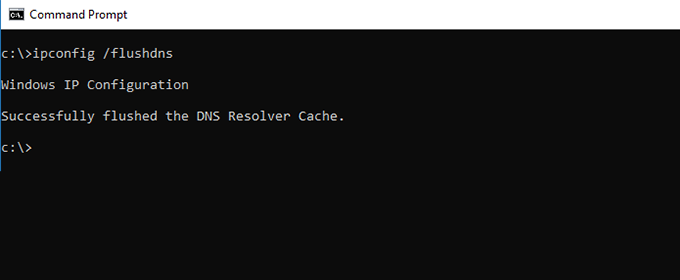
To be taught extra, please see our information on the best way to clear your DNS cache.
Troubleshooting WordPress DNS-Associated Points
When operating a WordPress web site, you’ll usually encounter totally different DNS-related points.
Right here’s a better take a look at among the errors chances are you’ll face and the way rapidly you may repair them.
1. DNS Server Not Responding
One of the crucial frequent WordPress errors customers come throughout is the ‘DNS server not responding’ difficulty.
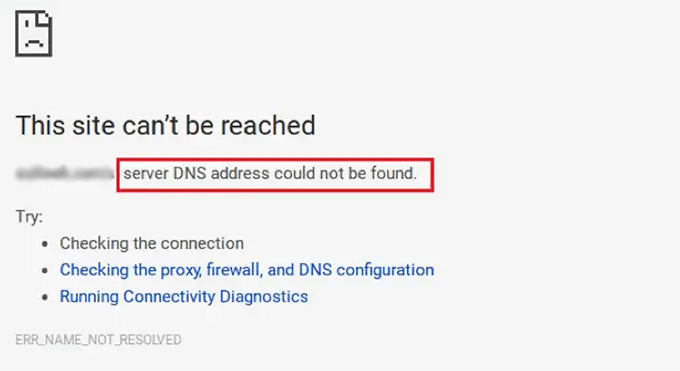
This error implies that your browser is unable to determine a reference to the servers which might be internet hosting the web site. It happens when the DNS supplier is unavailable, a firewall difficulty, or web connectivity issues.
To repair the ‘DNS server not responding’ error, you may test your web connection and guarantee it’s working correctly. Aside from that, you may as well attempt turning off the firewall or antivirus software program in your laptop.
Flushing or clearing the DNS cache in your system additionally helps repair this error. To be taught extra, please see our information on the best way to repair the DNS server not responding error in WordPress.
2. DNS_PROBE_FINISHED_NXDOMAIN Error
The DNS_PROBE_FINISHED_NXDOMAIN error is a Google Chrome error message that seems when the browser can’t find the web site you’re making an attempt to view.

The error happens when the DNS can’t discover or connect with the web site’s IP tackle. Consequently, the browser assumes that the web site doesn’t exist.
You will see that the identical difficulty in different browsers, like Mozilla Firefox, Microsoft Edge, and Safari. Nonetheless, the DNS error will look totally different.
To repair this difficulty, you can begin by clearing your laptop’s browser cache and DNS cache. It’s also possible to attempt utilizing Google’s public DNS servers and test your laptop’s host recordsdata.
For extra particulars, please see our information on the best way to simply repair the DNS_PROBE_FINISHED_NXDOMAIN error.
3. ERR_CONNECTION_RESET Error
One other difficulty chances are you’ll face is the ERR_CONNECTION_RESET error in your Google Chrome browser.
Often, this error implies that your WordPress web site is working, however one thing is stopping the browser from accessing it.
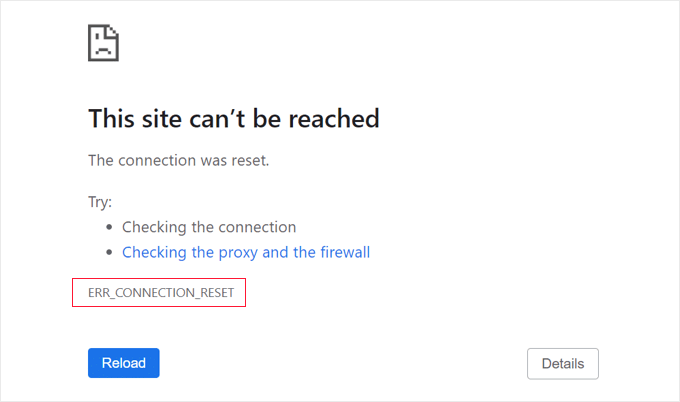
Whereas it’s not a DNS-related difficulty, it might happen if you happen to not too long ago moved the area to a brand new internet hosting platform or new area title.
One of many methods to repair it’s by flushing the DNS cache and altering your DNS cache, like Google Public DNS.
You may be taught extra by following the ideas in our information on the best way to repair the ERR_CONNECTION_RESET error in WordPress.
4. WordPress Redirecting to Previous Area After Migration
For those who not too long ago migrated your WordPress web site to a brand new area title and the redirection doesn’t work correctly, then customers could be redirected again to the previous area.
This error normally happens when the positioning URL and residential URL values are totally different within the WordPress database. Or the DNS server isn’t responding, or the DNS data haven’t been up to date.
To resolve this difficulty, you may first test your WordPress settings. Subsequent, attempt clearing the DNS cache so it’s up to date with the most recent DNS info.
You’ll find all of the methods to repair this difficulty by following our information on the best way to repair WordPress redirecting to the previous area after migration.
We hope this text helped you find out about WordPress DNS configuration. You might also wish to see our information on the best way to get a free SSL certificates in your WordPress web site and must-have WordPress plugins for enterprise websites.
For those who preferred this text, then please subscribe to our YouTube Channel for WordPress video tutorials. It’s also possible to discover us on Twitter and Fb.




